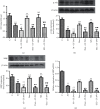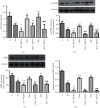Shenzhiling Oral Liquid Protects STZ-Injured Oligodendrocyte through PI3K/Akt-mTOR Pathway
- PMID: 32774416
- PMCID: PMC7396001
- DOI: 10.1155/2020/4527283
Shenzhiling Oral Liquid Protects STZ-Injured Oligodendrocyte through PI3K/Akt-mTOR Pathway
Abstract
White matter degeneration and demyelination are nonnegligible pathological manifestations of Alzheimer's disease (AD). The damage of myelin sheath consisting of oligodendrocytes is the basis of AD's unique early lesions. Shenzhiling oral liquid (SZL) was the effective Chinese herbal compound approved by the Food and Drug Administration (FDA) for the treatment of AD in China, which plays the exact therapeutic role in clinical AD patients. However, its molecular mechanism remains unclear to date. For this purpose, an in vitro mode of streptozotocin- (STZ-) induced rat oligodendrocyte OLN-93 cell injury was established to mimic the pathological changes of myelin sheath of AD and investigate the mechanism of SZL protecting injured OLN-93 cell. The results showed that STZ can decrease cell viability and downregulate the activity of PI3K/Akt-mTOR signalling pathway and the expression of myelin sheath-related proteins (MBP, MOG, and PLP) in OLN-93 cells. Both SZL-medicated serum and donepezil (positive control) can protect cells from STZ-caused damage. SZL-medicated serum increased OLN-93 cell viability in a dose- and time-dependent manner and enhanced the activity of PI3K/Akt-mTOR signalling pathway. The inhibitor of PI3K (LY294002) inhibited the protective effect of SZL-medicated serum on the STZ-injured OLN-93 cells. Furthermore, rapamycin, the inhibitor of mTOR, inhibited the promotion of cell viability and upregulation of p-mTOR and MBP caused by SZL-medicated serum. In conclusion, our data indicate that SZL plays its therapeutic role on AD by promoting PI3K/Akt-mTOR signalling pathway of oligodendrocytes. Thus, the present study may facilitate the therapeutic research of AD.
Copyright © 2020 Zhenhong Liu et al.
Conflict of interest statement
The authors declare that there are no conflicts of interest regarding the publication of this paper.
Figures








Similar articles
-
Shenzhiling oral solution promotes myelin repair through PI3K/Akt-mTOR pathway in STZ-induced SAD mice.3 Biotech. 2021 Jul;11(7):361. doi: 10.1007/s13205-021-02900-x. Epub 2021 Jul 1. 3 Biotech. 2021. PMID: 34295606 Free PMC article.
-
Shenzhiling oral liquid protects the myelin sheath against Alzheimer's disease through the PI3K/Akt-mTOR pathway.J Ethnopharmacol. 2021 Oct 5;278:114264. doi: 10.1016/j.jep.2021.114264. Epub 2021 Jun 1. J Ethnopharmacol. 2021. PMID: 34082015
-
Study on myelin injury of AD mice treated with Shenzhiling oral liquid in the PI3K/Akt-mTOR pathway.Int J Immunopathol Pharmacol. 2020 Jan-Dec;34:2058738420923907. doi: 10.1177/2058738420923907. Int J Immunopathol Pharmacol. 2020. PMID: 32462951 Free PMC article.
-
Shen-Zhi-Ling oral liquid ameliorates cerebral glucose metabolism disorder in early AD via insulin signal transduction pathway in vivo and in vitro.Chin Med. 2021 Dec 2;16(1):128. doi: 10.1186/s13020-021-00540-0. Chin Med. 2021. PMID: 34857022 Free PMC article.
-
Potential synaptic plasticity-based Shenzhiling oral liquid for a SAD Mouse Model.Brain Behav. 2019 Sep;9(9):e01385. doi: 10.1002/brb3.1385. Epub 2019 Aug 20. Brain Behav. 2019. PMID: 31429527 Free PMC article.
Cited by
-
Comprehensive analysis of mRNAs in the cerebral cortex in APP/PS1 double-transgenic mice with Alzheimer's disease based on high-throughput sequencing of N4-acetylcytidine.Funct Integr Genomics. 2023 Aug 7;23(3):267. doi: 10.1007/s10142-023-01192-z. Funct Integr Genomics. 2023. PMID: 37548859
-
Shen Zhi Ling oral liquid improve neuroinflammation against Alzheimer's disease via the PI3K/Akt pathway.3 Biotech. 2025 Jan;15(1):29. doi: 10.1007/s13205-024-04182-5. Epub 2025 Jan 2. 3 Biotech. 2025. PMID: 39760003
-
White Matter Injury in Central Nervous System Disorders.Neuropsychiatr Dis Treat. 2025 Jan 24;21:107-114. doi: 10.2147/NDT.S498660. eCollection 2025. Neuropsychiatr Dis Treat. 2025. PMID: 39877856 Free PMC article. Review.
-
Investigating the therapeutic effects of Shenzhiling oral liquid on Alzheimer's disease: a network pharmacology and experimental approach.3 Biotech. 2025 Jan;15(1):14. doi: 10.1007/s13205-024-04181-6. Epub 2024 Dec 17. 3 Biotech. 2025. PMID: 39703418
-
Shenzhiling oral solution promotes myelin repair through PI3K/Akt-mTOR pathway in STZ-induced SAD mice.3 Biotech. 2021 Jul;11(7):361. doi: 10.1007/s13205-021-02900-x. Epub 2021 Jul 1. 3 Biotech. 2021. PMID: 34295606 Free PMC article.
References
LinkOut - more resources
Full Text Sources
Research Materials
Miscellaneous

